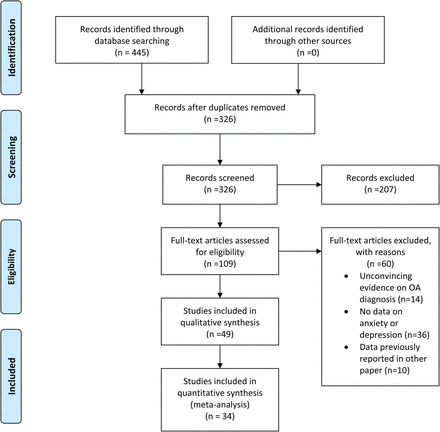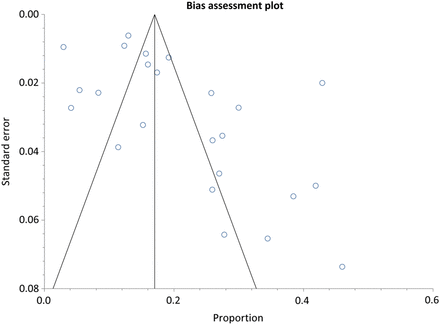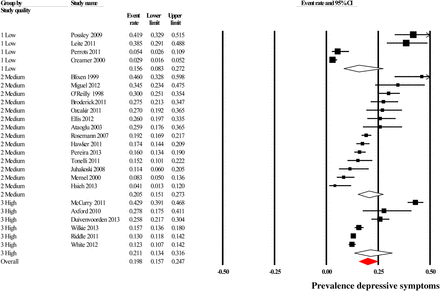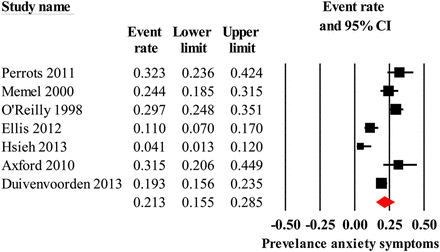-
PDF
- Split View
-
Views
-
Cite
Cite
Brendon Stubbs, Yetty Aluko, Phyo Kyaw Myint, Toby O. Smith, Prevalence of depressive symptoms and anxiety in osteoarthritis: a systematic review and meta-analysis, Age and Ageing, Volume 45, Issue 2, March 2016, Pages 228–235, https://doi.org/10.1093/ageing/afw001
Close - Share Icon Share
Abstract
Objective: osteoarthritis is a leading cause of disability. This systematic review aimed to establish the prevalence of depressive symptoms and anxiety among people with osteoarthritis in comparison to those without osteoarthritis.
Method: we systematically reviewed databases including AMED, EMBASE, MEDLINE, PsycINFO, BNI, CINAHL and the Cochrane database library from their inception to January 2015. Studies presenting data on depressive symptoms and anxiety in people with osteoarthritis were included. A random- and fixed-effect meta-analysis was conducted on all eligible data.
Results: a total of 49 studies were included, representing 15,855 individuals (59% women; mean age 65.2 years). The evidence base was moderate in quality. The pooled prevalence of depressive symptoms in osteoarthritis was 19.9% (95% confidence intervals (CI): 15.9–24.5%, n = 10,811). The corresponding pooled prevalence was 21.3% (95% CI: 15.5–28.5%; n = 1,226) for anxiety symptoms. The relative risk of depression among people with osteoarthritis was 1.17 (95% CI 0.69–2.00, three studies, n = 941) compared with people without osteoarthritis. The relative risk of anxiety was 1.35 (95% CI: 0.51–3.59; three studies, n = 733) compared with those without osteoarthritis.
Conclusion: one-fifth of people with osteoarthritis experience symptoms of depression and anxiety. However, it is uncertain whether this is increased compared with those without osteoarthritis, with no direct evidence to support an increase in anxiety and depression in osteoarthritis.
PROSPERO Registration Number: CRD42013006733.
Introduction
Osteoarthritis is a chronic, degenerative, musculoskeletal disease with global prevalence of 10% of men and 20% of women >60 years [1]. While life expectancy has increased globally [2, 3], people are also experiencing more years lived with disability due to such musculoskeletal conditions [4]. Osteoarthritis often has a profound impact on an individual's health and well-being since it is associated with increased pain, decreased function and elevated disability [5, 6], with the concomitant difficulties experienced in maintaining activities of daily living [7] and subsequent reductions in quality of life [8]. Thus, it is unsurprising that people with osteoarthritis are at greater risk of experiencing mental health problems [9–11]. A substantial body of literature has established that chronic pain, a common feature with osteoarthritis, is associated with depressive and anxiety symptoms [10, 11].
Recently, the importance of major depression, depressive symptoms and anxiety among people with osteoarthritis has gained increasing recognition [7]. Depressive symptoms were highlighted as a potential barrier to physical activity for people with osteoarthritis in a recent systematic review [12]. This is important as physical activity has been demonstrated to reduce pain and disability in this population [13]. Gleicher et al. [14] reported that among a cohort of over 2,000 individuals with probable osteoarthritis, 29% had probable depression yet almost half did not receive any mental healthcare support. This is despite a recent evidence suggesting that cognitive behavioural therapy, exercise and integrated depression management may improve outcomes for those with osteoarthritis and co-morbid depression [15].
A recent review established that depressive symptoms were highly prevalent among people with rheumatoid arthritis and associated with poorer outcomes [16]. It remains unclear whether this extends to osteoarthritis. However, no study to date has attempted to systematically review and quantify the prevalence of depression and anxiety in osteoarthritis through meta-analysis techniques. We therefore aimed to address this limitation and to provide robust evidence on clinical relevance and importance of symptoms of depression and anxiety in osteoarthritis.
Materials and methods
This systematic review was conducted within the Reporting Items for Systematic reviews and Meta-Analyses (PRISMA; [17]) statement and followed a predetermined registered protocol (PROSPERO: CRD42013006733).
Search strategy
Three authors (B.S., Y.A., T.O.) searched major electronic databases (AMED, EMBASE, MEDLINE, PsycINFO, BNI, CINAHL, the Cochrane library), grey literature and trial databases (OpenGrey (System for Information on Grey Literature in Europe), WHO International Clinical Trials Registry Platform, Current Controlled Trials and the United States National Institute of Health Trials Registry) from inception until 14th January 2015. The search terms used for the MEDLINE search are presented as Supplementary data, Table S1, available in Age and Ageing online and these were modified for each database. We conducted citation chasing search strategy with all reference lists of included articles and relevant review papers were considered to identify potentially omitted articles. Finally, all corresponding authors were emailed to consult whether any currently unpublished or previously unidentified papers could be incorporated into the final review.
Eligibility criteria
Studies were eligible if they met the following criteria: (i) case–control, cohort or intervention studies (using baseline data only) with or without a comparison group without osteoarthritis; (ii) reported the prevalence, incidence or relationship of major depression, depressive symptoms and/or anxiety in adults diagnosed with osteoarthritis of any joint. We accepted studies that diagnosed major depression through a structured clinical interview (the gold standard) and also those that defined depressive symptoms through an appropriate screening measure, for example the Patient Health questionnaire (PHQ, [18]). We accepted a diagnosis of osteoarthritis determined through a combination of clinical signs and symptoms and/or radiological evidence of degenerative osteoarthritis changes in line with recognised international criteria (American College of Rheumatologists [19]).
We excluded single-case studies and animal studies but did not exclude studies based on the year or language of publication. Studies that recruited people with non-osteoarthritis diagnoses such as rheumatoid arthritis, fibromyalgia or chronic pain were excluded. Papers reporting depressive symptoms and anxiety in cohorts with joint replacement (arthroplasty) were excluded. If we encountered studies with participants with mixed diagnosis (e.g. some with osteoarthritis and rheumatoid arthritis), we contacted the authors to acquire the osteoarthritis specific data. If we encountered multiple publications from the same cohort, we used the data from the most recent and/or paper reporting data from the largest number of participants.
Study identification
Two authors (B.S., Y.A.) independently reviewed the titles and abstracts from potentially relevant papers identified through the search strategy. The full text of all potentially eligible papers were reviewed independently by the two authors (B.S., Y.A.) before making a final decision on eligibility. Any disagreements in paper eligibility were resolved through a third reviewer (T.S.).
Outcome measures
The outcomes of interest were major depression diagnosed with a structured clinical assessment (e.g. DSM-IV [20] or ICD 10) or depressive symptoms and/or anxiety assessed with a validated assessment tool or screening measure (for example the Hospital Anxiety and Depression Scale, Centre for Epidemiologic Studies Depression Scale or Geriatric Depression Scale, CES-D).
Data extraction
Two authors (B.S., Y.A.) independently extracted data. The data extracted included characteristics of study participants, details of osteoarthritis (method of diagnosis, severity according to pain on a visual analogue scale (VAS), functional impairment, e.g. Western Ontario and McMaster Universities (WOMAC) or radiological details such as Kellgren–Lawrence scale) [21] details of co-morbidities, method of assessing depression/anxiety and the results. Wherever possible, we extracted the number affected and not affected by depression/depressive symptoms/anxiety in each sample (using the authors' cut-off points for each outcome measure). If this was not available, we extracted the mean and standard deviation of the depression/anxiety assessment scale.
Critical appraisal
Two authors (B.S., Y.A.) critically appraised each included paper using a tool based on the CASP ‘Case Control’ and ‘Cohort’ appraisal tools (CASP, [22]). Studies were classified as high, moderate and low quality using the threshold values of low (0–5 points), moderate (6–8 points) and high (9–10 points). Any disagreements in data extraction and appraisal were resolved through discussion between the two reviewers (B.S., Y.A.) or adjudication with a third reviewer (T.S.).
Data analysis
Three analyses were undertaken. First, we pooled studies reporting the prevalence of depression (including depressive symptoms) and anxiety in the osteoarthritis sample using a random-effects meta-analysis. Second, we conducted a meta-analysis using a pooled relative risk (RR) analysis with random-effect (RE) model to compare the risk of depressive symptoms and anxiety in osteoarthritis and non-osteoarthritis cohorts. Third, when studies reported mean scores for the depressive symptoms and anxiety, we conducted a pooled standardised mean difference (SMD) analysis to investigate differences between those with and without osteoarthritis. Statistical heterogeneity was assessed using I2 statistical test [23]. Publication bias was assessed with a visual inspection of a funnel plot and the Egger's bias value.
Wherever possible, subgroup analyses were conducted to assess the difference in symptoms of depression and anxiety between those who present with OA of different joints, e.g. knee versus hip, and those presenting with multiple joint symptoms. A subgroup analysis was also undertaken to compare results from studies conducted with cohort from the USA compared with Europe. Sensitivity analyses were undertaken when there were sufficient numbers of studies presenting with variation in study quality. In such instances, we compared the meta-analysis findings from high-, moderate- and low-quality studies. Finally, a meta-regression was undertaken to explore the influence of age on prevalence of depression and the influence of study quality on the prevalence of depression and anxiety in people with osteoarthritis.
Statistical analyses were conducted on RevMan (Review Manager) Version 5.1 (Copenhagen: The Nordic Cochrane Centre, The Cochrane Collaboration, 2011), STATA version 11.0 (StataCorp LP, Texas, USA) and statsdirect (Statsdirect ltd, Chester, UK).
Results
Search results
A total of 445 citations were identified. From this, 109 were potentially eligible and considered in the full-text review. Sixty articles were excluded; thus, 49 records met the eligibility criteria and were included. A summary of the search results is presented in Figure 1.

Critical appraisal
A summary of the critical appraisal results is presented in Supplementary data, Table S2, available in Age and Ageing online. As this represents, the evidence base was largely moderate in quality. On specific assessment of the criteria, the evidence base was largely strong in relation to clearly presenting a research question (n = 48 studies) and recruitment of clearly defined cohorts through transparent approach (n = 49). However, recurrent limitations to the evidence base included not clearly defining and then adjusting for all important confounding factors such as age, co-morbidities and severity of osteoarthritis, as seen in 27 studies.
Characteristics of included studies
A summary of the included study characteristics is presented in Supplementary data, Table S3, available in Age and Ageing online. A total of 15,855 participants were included in the 49 papers with a mean age of 65.2 years (standard deviation: 5.2). This included 5,382 males and 9,422 females; the gender-mix was not presented in four studies representing 1,051 individuals [20–23]. The most frequently assessed anatomical region of osteoarthritis was the knee (n = 24), followed by mixed lower limb osteoarthritis (n = 12) and hip and/or knee osteoarthritis together (n = 9). Two studies solely assessed people with hip osteoarthritis, while one study assessed people with hand osteoarthritis. A single study did not classify the anatomical region of their cohort with osteoarthritis [24]. Only 10 studies reported the duration of symptoms, ranging from 5.3 months [25] to 19 years [23].
Most studies were conducted in the USA (n = 20). Other studies were conducted in the UK (n = 5), Turkey (n = 4), Canada (n = 4) and Taiwan (n = 3). Individual studies were conducted in Ireland, Brazil, New Zealand, Germany, Finland and Korea.
The methods employed to assess anxiety and depressive symptoms and the frequency of their use are presented in Supplementary data, Table S4, available in Age and Ageing online.
Thirteen studies reported details regarding the type or frequency of co-morbidities among participants. From the studies that assessed co-morbidities, the number ranged from 2.1 [26] to 3.1 [27]. When the specific type of co-morbidity was presented, the most commonly presented were hypertension, metabolic disorders, cardiovascular disease, diabetes mellitus and osteoporosis [28, 29]. The mean VAS pain score for the cohorts was presented in 14 studies and was 4.28 (SD = 1.5) ranging from 2.4 [30] to 6.4 [31].
Meta-analysis
A summary of the meta-analysis results is presented in Supplementary data, Tables S5 and S6, available in Age and Ageing online.
Publication bias
Figure 2 demonstrated an asymmetrical funnel plot for the prevalence of depressiveness in people with osteoarthritis, suggesting evidence of some publication bias although quantitative testing with Egger bias confirmed this was not significant (intercept 1.2, P = 0.5). Individual egger bias test scores are presented for each analysis in Supplementary data, Table S5, available in Age and Ageing online.

Depressive symptoms
Prevalence and relative risk of depressive symptoms in people with osteoarthritis
A summary of the prevalence data for osteoarthritis and depressive symptoms is presented in Supplementary data, Table S5, available in Age and Ageing online. In brief, data from 24 studies (n = 10,506) established that the pooled prevalence of depressive symptoms in people with osteoarthritis was 19.9% (95% CI: 15.9–24.5%; I2: 96.1%; Figure 3). The prevalence of depressive symptoms was 15.6% (95% CI: 8.3% to 27.2; N = 4), 20.5% (95% CI: 15.1–27.3%) and 21.1% (95% CI: 13.4–31.6%) in low-, medium- and high-quality studies, respectively (Figure 3).

Forest plot of prevalence of depressive symptoms in people with osteoarthritis (ordered descending with the highest mean age the first plot).
The pooled prevalence of depressive symptoms across 11 studies (n = 6,722) in adults with isolated knee osteoarthritis was 18.5% (95% CI: 13.8–23.7%; I2: 85.4%). The prevalence was 23.0% (95% CI: 16.4–30.2%; I2: 95.8%) among 4,039 people with mixed lower limb osteoarthritis. There was a greater prevalence of depressive symptoms in people with osteoarthritis from studies conducted in the USA (23.1%; 95% CI: 14.6–32.8%; I2: 95.8%) compared with Europe (19.9%; 95% CI: 15.8–24.3%; I2: 90%).
Four studies included data on depressive symptoms for people without osteoarthritis. A pooled relative risk (RR) of 0.49 (95% CI: 0.10–2.45; I2: 96.5; n = 1,490; Supplementary data, Figure S1, available in Age and Ageing online) was established. Visual inspection of the forest plot demonstrated that one study was an obvious outlier [32]. Therefore, in a sensitivity analysis, this low-quality study was removed and the pooled relative risk was 1.17 (95% CI: 0.69–2.00) among three medium-quality studies.
Depressive symptoms in osteoarthritis versus non-osteoarthritis cohorts
Four studies (n = 736) presented data comparing depressive symptom scores for people with osteoarthritis compared with those without osteoarthritis. No significant differences were observed in studies using the GDS or CES-D (SMD: 0.64; 95% CI: −0.24 to 1.52). There was no significant difference in the CES-D either when assessing people with isolated knee osteoarthritis (MD: 0.83, 95% CI: −0.62 to 2.29).
Meta-regression of age and study quality on depression
Neither mean age of the osteoarthritis samples nor study quality moderated for the prevalence of depression in the meta-regression analysis (age: P = 0.75; goodness of fit: I2 = 95.0%; study quality: P = 0.71; goodness to fit: I2 = 96.1%). However, mean age explained some of the statistical heterogeneity observed in the results (R2 = 0.12). Study quality did not explain the statistical heterogeneity (R2 = 0.02).
Anxiety symptoms
Prevalence of anxiety symptoms in osteoarthritis cohorts
A summary of the prevalence data for osteoarthritis and anxiety is presented in Supplementary data, Table S6, available in Age and Ageing online. The pooled prevalence of anxiety symptoms across seven studies (n = 1,226) among people with osteoarthritis was 21.3% (95% CI: 15.5–28.5%; I2: 88.9%; Figure 4). The pooled prevalence of anxiety symptoms across four studies including 665 individuals with isolated knee osteoarthritis was 15.8% (95% CI: 7.5–25.1%; I2: 87.7%). The prevalence of anxiety was 28.2% (95% CI: 23.0–33.8%; I2: 12.6%) among 315 people with lower limb osteoarthritis. It was possible to undertake a subgroup analysis to assess the prevalence of anxiety in people with osteoarthritis from studies undertaken in Europe alone. This reported a prevalence of 26.6% (95% CI: 21.1–32.4%; I2: 72.1%, n = 999).

Forest plot of prevalence of anxiety in people with osteoarthritis (ordered descending with the highest mean age the first plot).
The relative risk of anxiety was 1.35 (95% CI: 0.51–3.59; I2: 52.4; n = 733; Supplementary data, Figure S2, available in Age and Ageing online), indicating no significant differences in anxiety. Caution should be attached to this as only two studies were included in the comparative analysis.
Anxiety symptoms score in osteoarthritis versus non-osteoarthritis cohorts
No studies provided data to compare anxiety symptom scores for people with osteoarthritis compared with those without in case-controlled studies.
Meta-regression of study quality on anxiety
Study quality did not moderate the prevalence of anxiety in the meta-regression analysis (P = 0.51; goodness to fit: I2 = 87.3%). However, study quality explained some of the statistical heterogeneity observed in the results (R2 = 0.24).
Discussion
Our results suggest that people with osteoarthritis experience concerning levels of depressive symptoms (∼20%). These findings mirror that of the rheumatoid arthritis population where depression has been reported as highly prevalent [16]. However, it remains unclear whether people with osteoarthritis are at a higher risk of experiencing depressive symptoms compared with general population because of the paucity of comparative data. Furthermore, around a fifth of people with osteoarthritis also experience anxiety, but again it is unclear whether this elevated compared with people without osteoarthritis due to the paucity of studies that provided comparative data.
These results did not find any direct evidence to support an increase in anxiety and depression in people with osteoarthritis. However, the results reported higher depression and anxiety than previous population estimates where the prevalence of clinically relevant depression has been estimated at 15% [32] and anxiety 8–10% [33] in older people. The prevalence of these psychiatric morbidities is important in osteoarthritis since depressive symptoms may be a better predictor of disability than radiographic evidence of degenerative joint changes in people with osteoarthritis [34, 35]. Secondly, depression is associated with heightened pain and increased functional disability [36]. Thirdly, depressive symptoms are associated with a drastically reduced quality of life and are potential barriers to physical activity and social participation [7, 12]. Fourthly, depression is associated with a marked increased risk of falls in older people [37], which remain a leading cause of morbidity, admission to long-term care facilities and mortality [38]. Finally, individuals with osteoarthritis perceived as a disability appear more strongly related to depressive symptoms than actual functional performance [39]. Accordingly clinicians should be mindful of the importance of detection and multidisciplinary treatment of depression and anxiety in people with osteoarthritis [36].
The results of this review can be interpreted through considering possible mechanisms to explain the association between depressive symptomology and osteoarthritis. Both depression and osteoarthritis are associated with inflammation, and exercise may also reduce inflammation [40]. Moreover, a recent meta-analysis [41] demonstrated that non-steroidal anti-inflammatory drugs (NSAIDs) significantly reduce depressive symptoms and may also be an important treatment option for those with pain symptoms.
While this is the first review of its type, several limitations should be acknowledged. First, there was inadequate data to conduct subgroup analyses according to variables of interest such as gender, duration of osteoarthritis symptoms, number of joints affected, severity of pain or impact of age (e.g.<65 and >65 years). Second, almost all of the included studies defined depressive symptoms with a screening tool, but accuracy and utility of these instruments in people with osteoarthritis are undetermined. Lastly, there was evidence of some heterogeneity in some of the analyses, which was only partially accounted for in meta-regression analyses.
To conclude, people with osteoarthritis experience high levels of depressive symptoms and anxiety. This appears to be higher than the general population of a similar age [32, 33]. This is of high relevance as both have the potential to have a severe and deleterious impact on an individual's health and increase health-service utilisation. Clinicians should be mindful of these disorders in the management of people with osteoarthritis since they have the potential to exacerbate symptoms and have a detrimental effect on the quality of life and prognosis of this growing patient population. However, further research with better designed comparative studies of age, gender and medical morbidity matched cohorts are needed in community cohorts before recommendations are made for targeted screening and interventions for people with osteoarthritis. Indeed routine assessment of depression and anxiety could be argued to be part of the assessment of all people presenting with a chronic health conditions. Given the possible bi-directional nature of association and impact between physical and mental health, it would require to explore whether detecting and treating these mental health issues or better management of associated physical co-morbidities in these patients have significant benefits for patients.
Osteoarthritis is a growing disabling condition worldwide.
There is a high prevalance of anxiety and depression in people with osteoarthritis.
Depression and anxiety in people with osteoarthritis can increase pain and disability over those without these co-morbidities.
High-quality evidence is needed to determine prevalence of anxiety depression in osteoarthritic versus the general population.
Conflicts of interest
The manuscript has not been published or submitted anywhere else. All authors have contributed substantially to the conception and design, analysis and interpretation of data, drafting of the manuscript or making intellectual contribution to its content. All authors have approved the final manuscript.
References
The very long list of references supporting this review has meant that only the most important are listed here and are represented by bold type throughout the text. The full list of references is given in Supplementary data, Appendix 1, available in Age and Ageing online.




Comments